J. Yannis Bakos[*
March 1993
Revised June, 1993]
Erik
Brynjolfsson**
Copyright (c) 1993, 1994 Bakos and Brynjolfsson
All Rights Reserved
Published in
Journal of Management Information Systems, Fall, 1993.
Information Technology, Incentives
and the Optimal Number of
Suppliers
As Bakos and Kemerer [4] point out, the organizational implications of IT are increasingly the focus of research at the intersection of information systems and institutional economics. In this paper we study some aspects of buyer-supplier relationships with a theoretical model in the institutional economics tradition, following the research direction established in our earlier work [3]. However, while our earlier paper addressed the impact of the number of suppliers on the social surplus and pursued the maximization of social welfare, in this paper we adopt the perspective of a buyer firm wishing to pursue its narrow self-interest in maximizing its profits. Unlike much recent research on the institutional impacts of IT, this paper does not directly address the question of appropriate firm boundaries. Since there are a number of situations in which internal production is not a viable option, we start with the assumption that the decision to outsource has been made, and proceed to analyze the optimal strategy for a buyer firm which must choose the number of suppliers it will employ. We show that looking at coordination costs alone can provide an incomplete picture; incentives must also be considered in a more complete analysis.
The remainder of this paper presents a framework for analyzing the choice of an optimal number of suppliers. Section two discusses the tradeoff between coordination costs and improved supplier "fit". The third section introduces the concept of "incomplete contracts" and presents a model that considers the incentive impacts of increasing the number of suppliers. A key result is that the need to provide incentives for non-contractible investments can limit the desirable number of suppliers. The fourth section discusses the implications of this analysis, and the last section offers some concluding remarks.
Malone, Yates and Benjamin [22] argue that IT will facilitate a move from single-supplier arrangements ("hierarchies") to multiple supplier arrangements ("markets") because it reduces the costs of coordination with suppliers. According to this logic, technological developments which lower the cost of acquiring information about prices and product characteristics in a given market should increase to the number of suppliers considered, especially in markets with differentiated products [2]. It follows that, to the extent IT tends to lower coordination costs [9], its wide adoption should lead to an increase in the number of suppliers for most firms, other things being equal.
It may be assumed that potential suppliers offer products that differ in some desirable feature, such as price, product characteristics, or simply "fit". However, interacting with each supplier entails a coordination cost. After surveying a number of suppliers, the buyer firm selects the product offering that provides the best value according to its set of criteria. The optimal number of suppliers is determined by trading off the cost of further searches against the expected benefit from identifying a better supplier. A formalization of this tradeoff between coordination cost and fit, which is illustrated in Figure 1, can be found in [3].
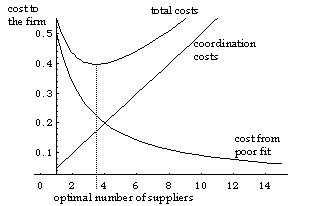
As mentioned earlier, it is widely believed that IT lowers the costs of inter-firm coordination. Figure 2 shows the impact of lower search costs on the curves of Figure 1, thus illustrating how lower search costs can lead to an increase in the number of suppliers. This increase is driven by the lower marginal cost of coordination with each additional supplier, and would occur even in the presence of a large set-up cost for initially establishing an interorganizational information system.
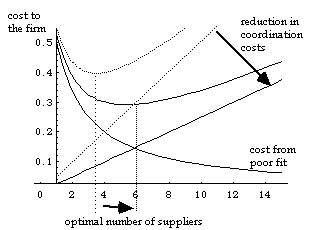
A danger of working with few suppliers is the higher risk that they will behave opportunistically and hold up the buyer [21, 26]. On balance, however, investments in IT are less likely to be relationship specific than other investments designed to reduce coordination costs between firms. As Clemons, Reddi and Row [8] have argued, IT can reduce the specificity of investments in buyer-supplier coordination while simultaneously improving the ability of the buyer to monitor compliance with contracts. As a result, the risk of opportunistic behavior inherent in "small numbers bargaining" situations, which involve bargaining among few parties highly dependent upon each other, can be greatly alleviated. Clemons, Reddi and Row argue that this will not only facilitate increased outsourcing, but will also enable firms to work with fewer suppliers.
An alternative explanation why IT could facilitate the move to a smaller number of suppliers is that it actually increases the total costs of coordination, leading to a steeper coordination cost curve in Figure 1, and resulting in the opposite effect from that depicted in Figure 2. For example, if the adoption of IT requires firms to make larger fixed technological and organizational investments to connect to each new supplier, firms will in turn employ fewer suppliers to economize on these coordination costs. Similarly, if investments in electronic integration are specific to a particular supplier, and thus are not transferable to new relationships, they create switching costs, which in turn limit the number of suppliers employed over a period of time.
In the aerospace industry, for example, Boeing is promoting tightly coupled relationships with its suppliers in developing the 777 aircraft, to deal with the extraordinary complexity of the project, while reducing costs and the length of the development period. This has required Boeing and several of its suppliers to adopt the same computer-aided design system (CATIA), to design procedures for the development and electronic interchange of compatible three-dimensional blueprints, and to make substantial organizational investments to promote direct communication between design teams at Boeing and the supplier firms. Such investments may tie a buyer firm to a particular set of suppliers, and may thus limit its ability to explore new suppliers.
While arguments like these may explain why investment in interorganizational information systems could initially reduce the number of employed suppliers, it is widely believed that in the long run IT lowers search costs and switching costs [8, 22]. For example, once an EDI standard has been adopted in an industry, the cost of basic electronic integration between any supplier and buyer who have implemented this standard will be relatively small. In Boeing's case, for example, adequate translation protocols exist for two-dimensional CAD drawings, and thus the setup cost of electronic integration with a potential supplier of parts which do not require three-dimensional blueprints is relatively low. Consequently any increase in transaction and coordination costs resulting from the adoption of IT is likely to be temporary. In fact, the increase in outsourcing that has been observed suggests that, on balance, there has not been an increase in transaction costs. Similarly, direct measures of most basic types of computer-aided transactions show rapid cost declines, averaging 25% per year [6]. Overall, the theoretical and empirical evidence appears to weigh heavily on the side of reduced coordination costs in the past decade.
In addition to reducing coordination costs, however, IT seems to facilitate the move to fewer suppliers. For example, Clemons, Reddi and Row [8] argue not only that recently there has been a "move to the middle" from both ends of the markets-hierarchies spectrum, but also that IT has been a significant driving force behind this trend. As they point out, this move to fewer suppliers and away from spot markets in the face of the presumed decline in coordination costs promulgated by IT, makes it important to account for factors other than coordination costs.
Infact this move to fewer suppliers is against conventional wisdom. For example, according to Porter's popular "five forces" model, firms should be eager to seize the opportunity to increase the number of their suppliers. In addition to potentially achieving a better fit, having more suppliers would reduce the potential of any one of them to bargain aggressively. Within the confines of such a framework, the move to fewer suppliers seems unwise. As Porter [24] put it:
In purchasing, then, the goal is to find mechanisms to offset or surmount these sources of suppliers' power. ... Purchases of an item can be spread among alternate suppliers in such a way as to improve the firm's bargaining position.
In this paper we advance the thesis that the increasing importance of non-contractible investments by suppliers, such as quality, information sharing and innovation, has forced firms to provide their suppliers with incentives to make these investments. As formally shown in the next section, reducing the number of suppliers increases their ex post bargaining power, and thus increases their ex ante incentives to make non-contractible relationship-specific investments. In other words, the suppliers will act more like "partners" who can reasonably expect to share in the gains from investment, and less like "contractors" who must be aggressively bargained with and monitored. While prior work in economics has emphasized the downside of "opportunism" inherent in bargaining with a small number of partners [26], our analysis shows how increasing the bargaining power of a firm's suppliers in some cases can improve the buyer's situation. Only a supplier who can credibly insist on a share of the benefits from the relationship will make investments above and beyond the "letter" of the contract. A buyer who strengthens his bargaining position by shopping with numerous alternative suppliers may ironically undercut the incentives of any one of them to make non-contractible investments. It may thus be optimal for a firm to employ fewer suppliers than the number dictated from the tradeoff between coordination costs and "fit".
Suppliers that make such non-contractible, relationship-specific investments must depend on the goodwill of the buyer or their own ex post bargaining power to reap a share of the benefits created by these investments. These considerations have largely been ignored in the more formal literature on buyer-supplier relations. Notable exceptions include Clemons, Reddi and Row [8] and Helper [16]. In particular, Clemons, Reddi and Row posit that closer relationships with suppliers can lower operations risk and opportunism risk, and they go on to argue that this will be especially true as the use of IT increases. These approaches, however, do not explicitly address how to provide incentives for supplier investment and, specifically, how the number of suppliers affects these incentives.
This section shows how adding incentive considerations to the coordination cost considerations previously addressed helps understand the move to fewer suppliers. While it has been shown that reducing the number of suppliers may be socially optimal in the sense of increasing the resulting social surplus [3], in this section we show that a buyer firm may be driven to reduce the number of suppliers it employs by its narrow self-interest. By committing to a small number of suppliers, the buyer firm can guarrantee them greater ex post bargaining power and therefore greater ex ante incentives to make non-contractible investments, such as investments in innovation, responsiveness and information sharing. The increased level of these supplier investments can more than compensate for the reduced bargaining power of the buyer firm, which ends up being better off by keeping a smaller piece of a bigger pie.
Intuitively, if non-contractible supplier investments are important, we might expect that the buyer does best for some intermediate level of bargaining power, as shown in Figure 3. When the buyer firm has no bargaining power, it won't get an adequate share of the non-contractible surplus; yet if it has all the power, then suppliers will not make any non-contractible investments, and there will be little to bargain over. This is consistent with the formal results from the model, as shown below in Figures 4 and 5.
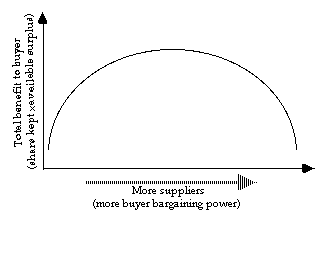
Figure 3: The tradeoff between buyer bargaining power and supplier investment.
Specifically, reducing the number of suppliers employed by the buyer firm will increase the bargaining power of each remaining supplier. This will increase the share of the marginal returns on investment received by these suppliers in ex post bargaining and, ultimately, their ex ante incentives to invest in the relationship. Thus when non-contractible supplier investments are important, limiting the number of suppliers may be the best way to insure that they have adequate incentives to make these investments. In the remainder of this section we present a model of buyer-supplier relationships that integrates incentive considerations with the coordination cost considerations discussed earlier.
In the second period, the buyer orders from the supplier with the most
desirable product characteristic, production takes place, the goods are
delivered, and payments are made.[2] Assets
are specific in the sense that a supplier must sell its output to the buyer to
create value, and similarly the buyer must gain access to the assets of at
least one supplier (e.g., by purchasing from that supplier) in order to create
value. We also make the standard assumptions of increasing marginal costs and
diminishing marginal returns to investment.[3]
![]()
![]()
![]()
![]()
In the absence of a contractual arrangement on sharing the profits from the non-contractible supplier investments, the surplus generated in the second period will be apportioned according the relative bargaining power of the parties involved.[4] Firms which are not easily replaced will have more bargaining power and thus will be able to garner a larger share of the surplus generated from transacting. The ex post bargaining power of the parties will have a considerable effect on their ex ante incentives to invest in quality: each firm will invest until the marginal benefit it expects to receive equals the marginal cost of investment. Thus, the first order conditions for each of the n supplier firms are given by the n equations,
![]() for i = 1, ... , n (1)
for i = 1, ... , n (1)
where x is the vector of investments xi (i = 1,...,n) and Bi(x) is the share of value received by firm i under investments x. Under the above assumptions, the bargaining power of each supplier, and therefore the value received Bi(x), is inversely related to the total number of suppliers with which the buyer contracts.[5] Thus increasing the number of suppliers will monotonically decrease their individual bargaining power, ex post surplus and incentives. Since reducing the incentives of any party will lead that party to invest less in the relationship, a key insight from equation (1) is that increasing the number of suppliers will reduce their non-contractible investments.
The buyer's problem in selecting the optimal number of suppliers n is to maximize the benefits from improved fit as the number of suppliers increases, while taking into account the negative impact on supplier incentives and the coordination costs [[kappa]](n). More formally, the buyer is trying to maximize:
![]() (2)
(2)
where the first term captures the impact of changing incentives for non-contractible supplier investments, the second term reflects coordination costs, and the third term shows the impact of improved "fit". Increasing the number of suppliers n will improve "fit" (i.e., the maximum [[epsilon]]i) but it will increase the coordination costs [[kappa]](n). It will also have a negative impact on the investment incentives of the suppliers. Thus if the buyer wishes to induce significant non-contractible investments from its suppliers, according to equation (1), it must commit to buying from a relatively small number of suppliers.
This model demonstrates that a number of tradeoffs need to be made in determining the optimal number of suppliers. Not only must coordination costs be balanced against improved fit, but the impact of the various arrangements on incentives must also be considered. For example, if non-contractible supplier investments are unimportant, the incentive considerations suggest that the buyer should adopt the maximum feasible number of suppliers. This allows the buyer firm to maximize its bargaining power and keep most of the surplus, while no supplier will make a significant non-contractible investment. On the other hand, if non-contractible supplier investments are critical, the buyer should employ relatively few suppliers. Although the buyer will be able to keep a smaller fraction of the surplus generated, reducing the number of suppliers will induce each of them to make the requisite non-contractible investments, and thus will increase the total surplus to be divided. In other words, as the suppliers' non-contractible actions become more important, the optimal number of suppliers decreases. This will be true even if coordination costs become arbitrarily small.
Figure 4 illustrates the relevant tradeoffs, when coordination costs are positive, for various values of [[Alpha]] (larger values of [[Alpha]] lead to higher curves). The figure shows how the number of suppliers that maximizes buyer surplus decreases as the importance of quality increases: the optimum when A is high (top curve) is at 1.5 suppliers vs. 2.6 suppliers when A is zero (bottom curve).
Figure 4: Coordination costs, "fit" and incentives
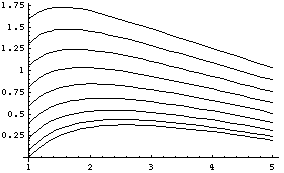

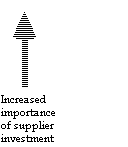
Figure 5 illustrates the corresponding tradeoffs when coordination costs are zero. If supplier investment is not important (bottom curve), the optimum number of suppliers is infinite. Each additional supplier slightly increases "fit", at no cost in coordination or incentives. The top curve is more interesting. It shows that the optimal number of suppliers is finite, (in this case 2) when it is important to provide incentives for non-contractible investments. The number of suppliers chosen by the buyer firm to maximize its surplus decreases as the importance of incentives increases, even with zero coordination costs.
Figure 5: Optimal number of suppliers when coordination costs are eliminated
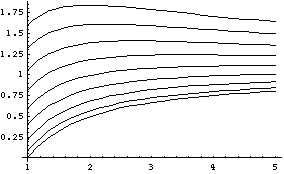


Investment characteristics Contractible Non-Contractible
Specific Many Few
Non-Specific Many Many
Table
1: Investment characteristics and incentive-compatible number of
suppliersOn the other hand, as pointed out in [3],
"... reducing the number of suppliers will not always be beneficial. If there is no importance attached to non-contractible investments, then it is best to increase the number of suppliers searched until the marginal cost of search equals the expected marginal benefit from improved fit. This suggests that incentive considerations can be effectively ignored for easily specified products such as commodities. For these products, continued reductions in coordination costs should lead to an increase in the number of suppliers considered."
The well-documented evolution of the airlines' computerized reservation systems is indicative of such a situation. The non-contractible investments made by individual travel agents and airlines in each other are neither large, nor relationship specific, at least insofar as choosing a flight for a traveler is concerned. Thus, the primary impact of the technology has been to reduce search costs. Consistent with the low significance of providing incentives for non-contractible investments, reducing coordination costs has resulted in increasing the average number of suppliers (airlines) considered for each purchase (reservation). There are some emerging "electronic markets", for instance in used cars, aircraft parts, computers and certain information services, that also fit this description.
A leading manager at Digital Equipment Corporation (DEC) points out that because of advances in information technology, both DEC and its suppliers now have far more detailed data on the projected demand for various products, the likely supplies that will be required to fulfill these needs and the potential cost savings created by various innovations or market conditions. Enormous opportunities for improved efficiency, increased flexibility and timeliness can be realized by the free sharing of this information. However, this same information can also be used to exploit the party that provides the information, for instance by demanding lower prices whenever the supplier has found a way to reduce costs. Thus, freely sharing the information requires not only that the technical infrastructure be put in place, but also that an atmosphere of "trust" and "partnership" be created. According to our model, by reducing the number of suppliers, a buyer can reassure its remaining suppliers that it will not (indeed cannot) exploit the information they share to appropriate all the benefits of the relationship. The above example shows one way in which IT has increased the importance of investment incentives and therefore can lead to what DEC terms "supplier partnerships".
While IT is frequently associated with increased exchanges of information, it is not a necessary prerequisite. For instance, another workshop participant, Bose Corporation, has instituted a system called JIT II, in which very high bandwidth information exchanges are enabled by having supplier representatives physically located in offices at Bose, which increases their ability to share information and to learn the details of Bose's needs. As predicted by our model, this increase in non-contractible information sharing has been associated with a move to fewer suppliers and increased reliance on partnerships. Having fewer suppliers helps assure that each party receives a fair share of the benefits from their investment in the relationship, and provides a partial safeguard against opportunistic behavior that could occur if Bose could easily threaten to switch to alternative suppliers. The success of Japanese firms in maintaining high-bandwidth communication between buyers and suppliers while keeping the number of alternative suppliers low is also consistent with this interpretation.
The DEC example suggests that the reason that American firms are now adopting a model closer to the Japanese partnership (or keiretsu) approach may not be simply a belated realization of the benefits from cooperation, but may result from changes in the underlying technology of production and coordination that have increased the importance of non-contractible investments. Indeed, Milgrom and Roberts [23] provide a formal model of "modern manufacturing" in which they argue that an emphasis on "quality" is a necessary complement for the successful use of "technologically advanced equipment". Similarly, exploiting IT to rapidly respond to changing market conditions may preclude detailed contracts or work rules. For instance, IT tends to automate the more routine tasks, which are typically those which are easiest to detail in a contract, leaving behind a residue of tasks that are neither automatable, nor contractible [5]. The result is an increased need to rely on institutional mechanisms, such as reducing the number of suppliers, to provide the appropriate incentives.
Furthermore, as discussed more extensively in [3], "... IT has contributed to the increased importance of non-contractibles, such as speed, flexibility and responsiveness throughout the economic environment, in the process increasing the number of future scenarios that would have to considered and provided for in any comprehensive contract between a buyer and a supplier. Furthermore,we believe that IT is likely to create a relative advantage for institutional over contractual governance mechanisms. In particular, IT facilitates the tracking of a large number of variables, enabling the efficient gathering of vast amounts of data, thus creating a large number of possible future contingencies. ... As a result, it has become relatively more cost-effective for both parties to share the benefits of their relationship relying on trust and ex post bargaining. In such an environment, a good partner is one who does not adhere merely to the "letter of the contract," but one who does whatever reasonably needs to be done. This requires an increased reliance on the institutional incentives available to deal with incomplete contracts, such as "partnering," leading to reduced numbers of suppliers and long-term relationships. In effect, IT has lead to a situation where the technology of production has outrun our ability write contracts that keep pace."
* Even when information technology provides the capability to cheaply connect to more potential suppliers, managers cannot ignore the incentive effects such a move will have. In particular, when providing incentives is important, working closely with a small number of supplier "partners" may be optimal, regardless of how low coordination costs become.
* Undermining the bargaining power of its suppliers can make a firm worse off, contrary to the standard competitive model. If a firm wants its suppliers to invest, it must guarantee them a fair share of the benefits, and sometimes this can only be done by limiting the number of alternative suppliers.
The ability to increase supplier incentives to invest in non-contractibles by reducing their number, and thus to partially compensate for the problems of incomplete contracting, provides an alternative perspective and an additional explanation for the "move to the middle". Furthermore, while in the long run IT will help reduce the coordination costs associated with a larger number of suppliers, the incentive considerations are more resistant to technological solutions, and are thus likely to remain in place for the foreseeable future. We showed that in this case, even if search and transaction costs are eliminated, it can still be optimal for a firm to limit the number of suppliers that it employs.
In our analysis, we have emphasized the role of IT in increasing the importance of non-contractible supplier investments such as quality, responsiveness and innovation. Although this inference is supported in our discussions with managers, it is possible that this new emphasis is unrelated to IT, and is simply due to a belated realization that these investments ultimately affect profits, or to an increasingly fierce competitive environment that makes quality a competitive necessity and forces firms to find new ways to differentiate their products. Whatever the forces driving the increasing importance of non-contractible investments, the end result will be an increased reliance on institutional factors to provide the right incentives, as we model in section 3 of this paper. This leads us to conclude that, even as technological developments continue to reduce coordination costs, the need to provide incentives for non-contractible investments will frequently limit the number of suppliers firms use.
[2] Bakos, J. Y. "A Strategic Analysis of Electronic Marketplaces." MIS Quarterly, Vol. 15, No. 3, 1991.
[3] Bakos, J. Y. and Brynjolfsson, E. "From Vendors to Partners: The Role of Information Technology and Incomplete Contracts in Buyer-Supplier Relationships." Journal of Organizational Computing, in press.
[4] Bakos, J. Y. and Kemerer, C. F. "Recent Applications of Economic Theory in Information Technology Research." Decision Support Systems, December, 1992.
[5] Brynjolfsson, E. Information Technology and the 'New Managerial Work'. Working Paper. MIT, 1990.
[6] Brynjolfsson, E. "The Productivity Paradox of Information Technology: Review and Assessment." Communications of the ACM, in press, 1993.
[7] Brynjolfsson, E., Malone, T., Gurbaxani, V. and Kambil, A. Does Information Technology Lead to Smaller Firms? Technical Report 123. MIT, Center Coordination Science, September, 1991.
[8] Clemons, E. K., Reddi, S. P. and Row, M. "The Impact of Information Technology on the Organization of Economic Activity: The "Move to the Middle" Hypothesis." Journal of Management Information Systems, 1993 (this issue).
[9] Clemons, E. K. and Row, M. "Information Technology and Economic Reorganization." In Proceedings of the 10th International Conference on Information Systems, (pp. 341-352). Boston, MA: 1989.
[10] Clemons, E. K. and Row, M. "Information Technology and Industrial Cooperation: The Changing Economics of Coordination and Ownership." Journal of Management Information Systems, Vol. 9, No. 2 (Fall), 1992, pp. 9-28.
[11] Coase, R. H. "The Nature of the Firm." Econ. N. S., Vol. 4, 1937, pp. 386-405.
[12] Cusumano, M. A. and Takeishi, A. "Supplier Relations and Management: A Survey of Japanese, Japanese-Transplant, and U.S. Auto Plants." Strategic Management Journal, Vol. 12, 1991, pp. 563-588.
[13] Grossman, S. and Hart, O. "The Costs and Benefits of Ownership: A Theory of Vertical and Lateral Integration." Journal of Political Economy, Vol. 4, 1986.
[14] Hart, O. and Moore, J. "Property Rights and the Nature of the Firm." Journal of Political Economy, Vol. 98, December, 1990, pp. 1119-1158.
[15] Hart, O. D. "Incomplete Contracts and the Theory of the Firm." Journal of Law, Economics and Organization, Spring, 1988.
[16] Helper, S. "How Much Has Really Changed between U.S. Automakers and Their Suppliers?" Sloan Management Review, Summer, 1991, pp. 15-27.
[17] Helper, S. Supplier Relations and Investment in Automation: Results of Survey Research in the U.S. Auto Industry. Working Paper. Dept. of Economics, Case Western Reserve University, September, 1991.
[18] Henderson, J. and Venkatraman, N. Strategic Alignment: A Model for Organizational Transformation via Information Technology. Working Paper, Center for Information Systems Research, MIT Sloan School of Management, November, 1990.
[19] Jarillo, J. C. "On Strategic Networks." Strategic Management Journal, Vol. 9, 1988, pp. 31-41.
[20] Johnston, R. and Lawrence, P. "Beyond Vertical Integration--the Rise of the Value-Adding Partnership." Harvard Business Review, July-August, 1988, pp. 94-101.
[21] Klein, B., Crawford, R. and Alchian, A. "Vertical Integration, Appropriable Rents and the Competitive Contracting Process." Journal of Law and Economics, Vol. 21, October, 1978, pp. 297-326.
[22] Malone, T. W., Yates, J. and Benjamin, R. I. "Electronic Markets and Electronic Hierarchies: Effects of Information Technology on Market Structure and Corporate Strategies." Communications of the ACM, Vol. 30, No. 6, 1987, pp. 484-497.
[23] Milgrom, P. and Roberts, J. "The Economics of Modern Manufacturing: Technology, Strategy, and Organization." American Economic Review, Vol. 80, No. 3, 1990.
[24] Porter, M. E. Competitive Strategy. New York, NY: The Free Press, 1980.
[25] Shapley, L. S. A Value for n-Person Games. In H. Kuhn and A. Tucker (Eds.), Contributions to the Theory of Games Princeton: Princeton University Press, 1953.
[26] Williamson, O. Markets and Hierarchies: Analysis and Antitrust Implications. New York: Free Press, 1975.

Figure
1: Balancing coordination costs and "fit"
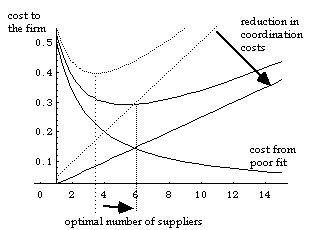
Figure
2: The effect of lower coordination costs

Figure 3: The tradeoff between buyer bargaining power and supplier investment.
Figure 4: Coordination costs, "fit" and incentives



Figure 5: Optimal number of suppliers when coordination costs are eliminated


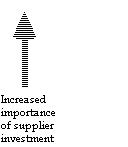
Investment characteristics Contractible Non-Contractible
Specific Many Few
Non-Specific Many Many
Table
1: Investment characteristics and incentive-compatible number of
suppliers